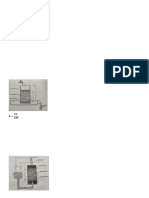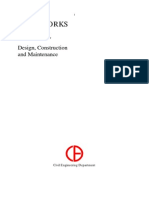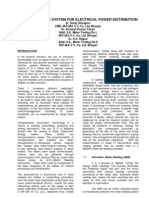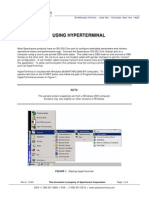Lecture8A (Flow&Seepage)
Lecture8A (Flow&Seepage)
Uploaded by
chouszeszeCopyright:
Available Formats
Lecture8A (Flow&Seepage)
Lecture8A (Flow&Seepage)
Uploaded by
chouszeszeOriginal Title
Copyright
Available Formats
Share this document
Did you find this document useful?
Is this content inappropriate?
Copyright:
Available Formats
Lecture8A (Flow&Seepage)
Lecture8A (Flow&Seepage)
Uploaded by
chouszeszeCopyright:
Available Formats
1
Lecture 8A
Flow and Seepage Around Tunnel
2
3
Steady State Flow Condition follow the Laplaces Equation (2-D):
head total H where
0
y
H
x
H
2
2
2
2
=
=
Solution is sought by two families of curves intersecting at right angles such
that:
Equipotential function (x,y)=constant (equipotential lines)
Stream function (x,y)=constant (flow lines)
Hydraulic Gradient, i is given as:
l
h
i =
e
f
n
n
kH q =
Darcys law, flow quantity q is given as:
k=coefficient of permeability
H=total head change
n
f
=number of flow channels
n
e
=number of equipotential drops
4
n
f
=10
n
e
=4.8
H=9m
k=10
-8
m/sec
q=1.9x10
-7
m
3
/sec/m length of tunnel
Fitzpatrick et. al. (1981)
5
Drawdown
(consolidation) and
Recharge
Fitzpatrick et. al. (1981)
6
Effect of Lining Permeability
Fitzpatrick et. al. (1981)
k
s
=permeability of soil
k
L
=permeability of
lining
d=18m
No lining
7
Effect of Layered Soil
(Tunnel intersecting sand layer)
Fitzpatrick et. al. (1981)
8
Fitzpatrick et. al. (1981)
9
Allowable
Infiltration Rate
ORourke (1984)
10
Allowable
Infiltration Rate
11
Spectacular Water Problems Experienced elsewhere:
Tanna Tunnel Japan (1925) 2000 l/s inflows
Eklutna Tunnel Alaska (1951) 1200 l/s in a fault zone
Kurobe Tunnel Japan (1965) 700 l/s in a fault zone
Seikan Tunnel Japan (1980) 1200 l/s in a fault zone
SSDS Tunnel C Hong Kong (1999) ??? l/s in a fault zone
12
Strategic Sewage Disposal Scheme Stage 1
DC/96/17 - Completion works for Transfer System from CW to KT and from TKO to KT
Water Inflow in Tunnel C
0
1000
2000
3000
4000
5000
6000
7000
8000
9000
10000
2
3
-
J
a
n
-
9
9
1
4
-
M
a
r
-
9
9
0
3
-
M
a
y
-
9
9
2
2
-
J
u
n
-
9
9
1
1
-
A
u
g
-
9
9
3
0
-
S
e
p
-
9
9
1
9
-
N
o
v
-
9
9
0
8
-
J
a
n
-
0
0
2
7
-
F
e
b
-
0
0
1
7
-
A
p
r
-
0
0
0
6
-
J
u
n
-
0
0
2
6
-
J
u
l
-
0
0
1
4
-
S
e
p
-
0
0
0
3
-
N
o
v
-
0
0
2
3
-
D
e
c
-
0
0
1
1
-
F
e
b
-
0
1
0
2
-
A
p
r
-
0
1
2
2
-
M
a
y
-
0
1
1
1
-
J
u
l
-
0
1
Date
W
a
t
e
r
p
u
m
p
e
d
o
u
t
t
o
s
u
r
f
a
c
e
(
L
i
t
e
r
/
m
i
n
)
0
1000
2000
3000
4000
5000
C
h
a
i
n
a
g
e
(
m
)
Water Inflow Reading Tunnel Excavation In-situ concrete lining construction
Tunnel Excavation
1st stage
Lining
Invert
concrete
Final stage in-situ
concrete lining
Grouting and repairing of the
in-situ concrete lining
Crossing water
features at Ch. 1440
Crossing Rennie's
Mill Fault
13
Drawdown (consolidation) modelling
14
Prediction of Inflow of Rock Tunnel under Sea (Freeze and Cherry, 1979):
For homogenous, isotropic and steady
state condition where,
k=hydraulic conductivity
h=depth of tunnel
h
r
=thickness of rock cover
r= tunnel radius
Q=inflow rate per unit length of
tunnel
=
r
2h
log
kh
7318 . 2 Q
r
15
Prediction of Inflow (Goodman, 1965):
16
Prediction of Inflow (Goodman, 1965):
For Homogeneous Isotropic Aquifer with
constant head:
Q=Flow per unit length of excavation
K=hydraulic conductivity of jointed rock
mass
D=average depth of excavation below ground
level
H=hydraulic head (depth below groundwater
table)
r= tunnel radius
=
r
2D
ln
KH 2
Q
This equation predicts that inflow (Q) into the
excavation is proportional to H/ln(D)
(increases with depth) if K is constant
17
Observations show
that hydraulic
conductivity
decreases with depth
due to joint closing
under higher
confining stresses
18
Prediction of Inflow (Zhao, J.): Inflow decreases with depth due to joint
closing with increase in effective normal stress (waste depository design)
where,
g=acceleration due to gravity
B=ratio of conductive joints to total joint
number (0.1-0.3 for jointed crystalline rock
mass)
=joint frequency (fracture index) of rock
mass
e
i
=joint aperture (estimate from core logging,
varies from 10 to 100 m) at shallow depth
D
i
=kinematic viscosity of fluid (0.0101
cm
2
/sec for pure water at 20
0
C)
A=0.14-0.22, a parameter indicating the
decrease of joint permeability with an
increase in effective stresses
2
i
2
i
D
D
Aln 1
r
2D
l 6
H gB
Q
=
n
e
This equation takes into account of the
variation of hydraulic conductivity with
stress (or depth) and the effect of
decreasing hydraulic conductivity may
counterweigh the effect of increasing
hydraulic head
19
2
i
2
i
D
D
Aln 1
r
2D
l 6
H gB
Q
=
n
e
=
r
2D
ln
KH 2
Q
K=1.0x10
-7
m/s
H=D
i
=50m
20
Artificial
Recharge to
reduce
Groundwater
Lowering
due to
Dewatering
by Tunnel
21
Zone of Influence
( )
( )
( )
( )
( ) trench or flow line 2000 to 1500
flow radial 3000 factor empirical C
m/s ty permeabili k
m drawdown h
k Ch R Influence of Radius
0
=
= =
=
=
=
Somerville (1986)
22
Types of Aquifers affecting quantity of flow
23
Measurement of Discharge
By meter
By estimation
(V-notch or pipe flowing)
Somerville (1986)
24
Non-
symmetrical
drawdown
Symmetrical
drawdown
Rock
Soil
Impermeable Layer
Uniform
Rock Mass
Conductive
Joints
Soil
25
Impermeable Layer
For the same rock
mass joint
distribution, inflow
control by tunnel
intersecting discrete
conductive joints
26
Recharge is
reliable in
homogenous soil
Recharge is unreliable
in fractured rock,
depending on
intersecting correct
flow path
27
Water Control Specification:
During tunnelling In Settlement Sensitive
Area, groundwater inflow to be reduced if:
Any probe hole recording more than 20
l/min, or
Inflow recorded more than 50 litre/min at
the tunnel face and within 25m of the
tunnel face or over any 50m length of
tunnel
Water tightness of permanent linings Inflow
of water shall not exceed 5 litres per 24 hours
per square metre of internal surface of lining
measured over any 100m length of completed
tunnel or shaft (SSDS Stage I tunnels contract)
28
Limitations of Probe Holes
29
30
You might also like
- A Practical Approach To Conditions of Contract For Civil Engineering WorksDocument268 pagesA Practical Approach To Conditions of Contract For Civil Engineering Workschouszesze100% (2)
- Vision and MissionDocument4 pagesVision and MissionNamithNo ratings yet
- PermeabilityDocument6 pagesPermeabilityhaynalanggidNo ratings yet
- Application of Groundwater FlowDocument25 pagesApplication of Groundwater Flowfuji100% (1)
- Flow Nets: Prepared By: Eng. Hayder M. Jasem AL-Mosawey Supervisor: Dr. Mohamed ShakerDocument23 pagesFlow Nets: Prepared By: Eng. Hayder M. Jasem AL-Mosawey Supervisor: Dr. Mohamed ShakerkhaleelNo ratings yet
- APPLIED HYDROGEOLOGY - WR423 - Lecture - Series - 3Document33 pagesAPPLIED HYDROGEOLOGY - WR423 - Lecture - Series - 3Winyi Patrick100% (1)
- Chapter 7 - PERMEABILITY PDFDocument39 pagesChapter 7 - PERMEABILITY PDFVivekka Olivia JohnNo ratings yet
- WEEKS79b-Well in A Uniform FlowDocument9 pagesWEEKS79b-Well in A Uniform FlowThabo ChuchuNo ratings yet
- 13 - Fluids at Rest and Piped FluidsDocument7 pages13 - Fluids at Rest and Piped FluidsVinay GuptaNo ratings yet
- Fluid MechanicsDocument52 pagesFluid Mechanicsmanneli talpagiriNo ratings yet
- Flow Nets: Aulianur AkbarDocument23 pagesFlow Nets: Aulianur AkbarAulia NurAkbarNo ratings yet
- Basic Subsurface Flow Steady State ConditionDocument79 pagesBasic Subsurface Flow Steady State ConditionMarianne Encabo80% (10)
- 6-Water in SoilDocument22 pages6-Water in SoilSamsung Note 5No ratings yet
- Fluid Mech. Chapter10 - UploadedDocument25 pagesFluid Mech. Chapter10 - UploadedBryan ChooiNo ratings yet
- 4 Flownets 170724070429Document16 pages4 Flownets 170724070429Joe NjoreNo ratings yet
- Experiment 1 - Friction Losses in Pipes-ReportDocument41 pagesExperiment 1 - Friction Losses in Pipes-ReportKhairil Ikram67% (3)
- CH2 Part2Document60 pagesCH2 Part2sertsemariammamushet2No ratings yet
- Lecture13 DewateringDocument30 pagesLecture13 DewateringLuiz AlvesNo ratings yet
- GATE 2022 Engineering Sciences XE Fluid Mechanics: XE-B (Q.22 - Q.30 Carry ONE Mark Each)Document16 pagesGATE 2022 Engineering Sciences XE Fluid Mechanics: XE-B (Q.22 - Q.30 Carry ONE Mark Each)Ishwar SinghNo ratings yet
- Open Channel Flow PPT SlideDocument70 pagesOpen Channel Flow PPT SlidenathanzdarikelozayiNo ratings yet
- Seepage and Ground Water Flows PaperDocument20 pagesSeepage and Ground Water Flows PapersharathknNo ratings yet
- Anisotropic Flow NetsDocument8 pagesAnisotropic Flow NetsHundeejireenyaNo ratings yet
- Flow NetDocument83 pagesFlow NetMekuanint ShitawNo ratings yet
- MejiaDocument11 pagesMejiaJUAN PABLO GARCIA RIVERANo ratings yet
- Analytical Solutions For Seepage Forces of Drained Circular TunnelDocument7 pagesAnalytical Solutions For Seepage Forces of Drained Circular TunnelEduardo Infante100% (1)
- Permeability of SoilDocument14 pagesPermeability of SoilRajesh KhadkaNo ratings yet
- 10 Open ChannelsDocument46 pages10 Open Channelsعبدالرحمن عامرNo ratings yet
- Topic T2: Flow in Pipes and Channels AUTUMN 2013Document30 pagesTopic T2: Flow in Pipes and Channels AUTUMN 2013Bernard PalmerNo ratings yet
- 流體力學Document30 pages流體力學sonkuas100% (1)
- CH 4Document40 pagesCH 4Mo KopsNo ratings yet
- Fluid Mechanics (XE (B) ) PDFDocument5 pagesFluid Mechanics (XE (B) ) PDFLucas SchroederNo ratings yet
- Open Channel FlowDocument75 pagesOpen Channel FlowPrince VinceNo ratings yet
- Experiment No - 1 Flow Through A Sluice GateDocument11 pagesExperiment No - 1 Flow Through A Sluice Gatesalman40% (5)
- Soil Mechanics 1 (ENG2001M)Document17 pagesSoil Mechanics 1 (ENG2001M)lkhdasouNo ratings yet
- 44CDocument9 pages44Cjhacademyhyd100% (3)
- 2.4 Rock PermeabilityDocument43 pages2.4 Rock PermeabilityKvspavan Kumar100% (1)
- Flow Resistance and Channel TransitionsDocument22 pagesFlow Resistance and Channel TransitionsAhmet AkkilicNo ratings yet
- Paper 334Document10 pagesPaper 334kamsNo ratings yet
- Flow Nets: Dipanjan Mukherjee Civil & Soil Engineering Wbut (Ait)Document23 pagesFlow Nets: Dipanjan Mukherjee Civil & Soil Engineering Wbut (Ait)Prasenjit PaulNo ratings yet
- Steady Flow in PipesDocument17 pagesSteady Flow in Pipeskasandra01No ratings yet
- Flow Measurement 1Document17 pagesFlow Measurement 1hiuNo ratings yet
- FM GateDocument50 pagesFM GateIndhira Devi PNo ratings yet
- PP4: Sanitary Sewer SystemDocument63 pagesPP4: Sanitary Sewer SystemMarco WongNo ratings yet
- Flow in SoilDocument46 pagesFlow in Soilsyazwan100% (1)
- Backw Descrip OnlineDocument6 pagesBackw Descrip Onlineba668899No ratings yet
- Fluid Mechanics: The Gate CoachDocument18 pagesFluid Mechanics: The Gate CoachSandeep CharanNo ratings yet
- Mathematical Modelling of A Comprehensive Solution To Chennai FloodDocument5 pagesMathematical Modelling of A Comprehensive Solution To Chennai Floodakj.usernameNo ratings yet
- Homework 1Document1 pageHomework 1dearjohnnydoNo ratings yet
- Water Surface ProfilesDocument10 pagesWater Surface ProfilesMagesh KumarNo ratings yet
- Lecture Notes in Permeability With PW (Permeability)Document30 pagesLecture Notes in Permeability With PW (Permeability)Mikasa AngelNo ratings yet
- Hydrology With Schematic Diagram ResearchDocument8 pagesHydrology With Schematic Diagram ResearchGleizel AutorNo ratings yet
- Week 8 10 Hydraulic Structures Part I WEIRSDocument50 pagesWeek 8 10 Hydraulic Structures Part I WEIRSgeorgedytrasNo ratings yet
- Circular Tunnel in A Semi-Infinite AquiferDocument7 pagesCircular Tunnel in A Semi-Infinite AquiferSaeed DelaraNo ratings yet
- Permeability of Soil: Pressure, Elevation and Total Heads: Under RevisionDocument10 pagesPermeability of Soil: Pressure, Elevation and Total Heads: Under RevisionRupali YadavNo ratings yet
- Open Channel Flow: Monroe L. Weber-Shirk S Civil Environmental EngineeringDocument62 pagesOpen Channel Flow: Monroe L. Weber-Shirk S Civil Environmental EngineeringsssshekharNo ratings yet
- HydraulicDocument18 pagesHydraulicShahram HawramiNo ratings yet
- The Mechanics of Water-Wheels - A Guide to the Physics at Work in Water-Wheels with a Horizontal AxisFrom EverandThe Mechanics of Water-Wheels - A Guide to the Physics at Work in Water-Wheels with a Horizontal AxisNo ratings yet
- Atlas of Structural Geological Interpretation from Seismic ImagesFrom EverandAtlas of Structural Geological Interpretation from Seismic ImagesAchyuta Ayan MisraNo ratings yet
- Reviews in Computational ChemistryFrom EverandReviews in Computational ChemistryAbby L. ParrillNo ratings yet
- Governing Mechanism of TunnelingDocument48 pagesGoverning Mechanism of TunnelingchouszeszeNo ratings yet
- Lecture12 (RockFoundation)Document49 pagesLecture12 (RockFoundation)chouszesze100% (1)
- D R D R:) (3 Side On Force RadialDocument55 pagesD R D R:) (3 Side On Force RadialchouszeszeNo ratings yet
- Lecture3 (RockTestingTechnique)Document50 pagesLecture3 (RockTestingTechnique)chouszeszeNo ratings yet
- Lecture (FEModelingforTunnel)Document0 pagesLecture (FEModelingforTunnel)chouszeszeNo ratings yet
- Lecture5 (ShearStrengthDiscontinuity)Document0 pagesLecture5 (ShearStrengthDiscontinuity)chouszeszeNo ratings yet
- Hoek-Diederichs Rock Mass Modulus-2006 EditionDocument13 pagesHoek-Diederichs Rock Mass Modulus-2006 Editionchouszesze100% (1)
- Lectures Stress and Small (Infinitesimal) Strain: CIVL 6038 Rock MechanicsDocument76 pagesLectures Stress and Small (Infinitesimal) Strain: CIVL 6038 Rock MechanicschouszeszeNo ratings yet
- Port Works ManualDocument191 pagesPort Works Manualchouszesze100% (1)
- 岩土英汉专业词典 PDFDocument84 pages岩土英汉专业词典 PDFshawnNo ratings yet
- Contract Strategy For Design Management in The Design and Build SystemDocument10 pagesContract Strategy For Design Management in The Design and Build SystemchouszeszeNo ratings yet
- How Practitioners Set Share Fractions in Target Cost ContractsDocument8 pagesHow Practitioners Set Share Fractions in Target Cost ContractschouszeszeNo ratings yet
- Understanding Time Delay Disputes in Construction ContractsDocument11 pagesUnderstanding Time Delay Disputes in Construction ContractschouszeszeNo ratings yet
- Producing A Programme Under The NEC Form of ContractDocument6 pagesProducing A Programme Under The NEC Form of ContractchouszeszeNo ratings yet
- The New Engineering Contract - A Promising Start BriefingDocument2 pagesThe New Engineering Contract - A Promising Start BriefingchouszeszeNo ratings yet
- CoP On Monitoring and Maintenance Water Carrying Services Affecting SlopesDocument96 pagesCoP On Monitoring and Maintenance Water Carrying Services Affecting SlopeschouszeszeNo ratings yet
- Construction Contract - The Cost of MistrustDocument6 pagesConstruction Contract - The Cost of MistrustchouszeszeNo ratings yet
- CAS ER New - PlusService Manual - 070703 - OIMLDocument86 pagesCAS ER New - PlusService Manual - 070703 - OIMLRpetrovichNo ratings yet
- Colocviu EnglezaDocument2 pagesColocviu EnglezaLivia Liv100% (1)
- Smart Metering System For Electrical Power DistributionDocument6 pagesSmart Metering System For Electrical Power DistributionSkumaran KumaranNo ratings yet
- Line Conventions and Lettering: ASME Y14.2-2008Document23 pagesLine Conventions and Lettering: ASME Y14.2-2008Hebert Fernando Cáceres MárquezNo ratings yet
- Using HyperterminalDocument4 pagesUsing HyperterminalstanvicNo ratings yet
- 04 - 41991Document12 pages04 - 41991mushfiq66No ratings yet
- CCD CatalogueDocument32 pagesCCD CatalogueSelvaa KumarNo ratings yet
- Thomas Golden ResumeDocument2 pagesThomas Golden ResumeRobert GilmoreNo ratings yet
- ProCash 2050xe ENGDocument158 pagesProCash 2050xe ENGiguzina100% (1)
- How To Interface GPS With 8051 MicrocontrollerDocument5 pagesHow To Interface GPS With 8051 MicrocontrollerSỹ RonNo ratings yet
- En 61000-4!7!2002 - CEI IEC - EMC-Part 4-7-Testing and Measurement Techniques - 2Document2 pagesEn 61000-4!7!2002 - CEI IEC - EMC-Part 4-7-Testing and Measurement Techniques - 2Mahmoud ShaheenNo ratings yet
- DX-9840E Service Manual DC-S84D1SDocument37 pagesDX-9840E Service Manual DC-S84D1Sritab7001No ratings yet
- CryptographyDocument6 pagesCryptographyThenmozhi RavichandranNo ratings yet
- Fluid Machines Lecture Notes CH-5-Axial Flowl CompressorDocument16 pagesFluid Machines Lecture Notes CH-5-Axial Flowl CompressorBINNo ratings yet
- OTC1514 FD Series Catalogue PDFDocument4 pagesOTC1514 FD Series Catalogue PDFMitchell DanielsNo ratings yet
- Understanding The Neher-McGrath Calculation and The Ampacity of ConductorsDocument7 pagesUnderstanding The Neher-McGrath Calculation and The Ampacity of ConductorsbhaskarinvuNo ratings yet
- Members Data 8Document2 pagesMembers Data 8jaime huertasNo ratings yet
- CEHv10 - Cheat Sheet - Part - IDocument132 pagesCEHv10 - Cheat Sheet - Part - Ibeta_beta100% (3)
- 9S Exca - Hyd p29Document29 pages9S Exca - Hyd p29AimHigh100% (5)
- Introduction of TransducerDocument6 pagesIntroduction of TransducerFairus AffiniNo ratings yet
- History of Brennan Motor Co. Building Complex in SyracuseDocument16 pagesHistory of Brennan Motor Co. Building Complex in SyracuseTim KnaussNo ratings yet
- Exp-7 3-Ph Vsi Fed PWM InvDocument5 pagesExp-7 3-Ph Vsi Fed PWM Invaman srivastavaNo ratings yet
- Rudding CatDocument63 pagesRudding CatLowkey LokeyNo ratings yet
- PolimorfismoDocument31 pagesPolimorfismoVictor ReynaNo ratings yet
- StudioBar110 User Manual FADocument14 pagesStudioBar110 User Manual FAabu kasimNo ratings yet
- Kw2 Bid DocumentDocument34 pagesKw2 Bid DocumentShiv RajNo ratings yet
- D60-Setting Example PDFDocument21 pagesD60-Setting Example PDFRicardo Hernandez100% (4)
- 15 Trans VRDocument32 pages15 Trans VRAkbarDwiSyahputraNo ratings yet










































































































